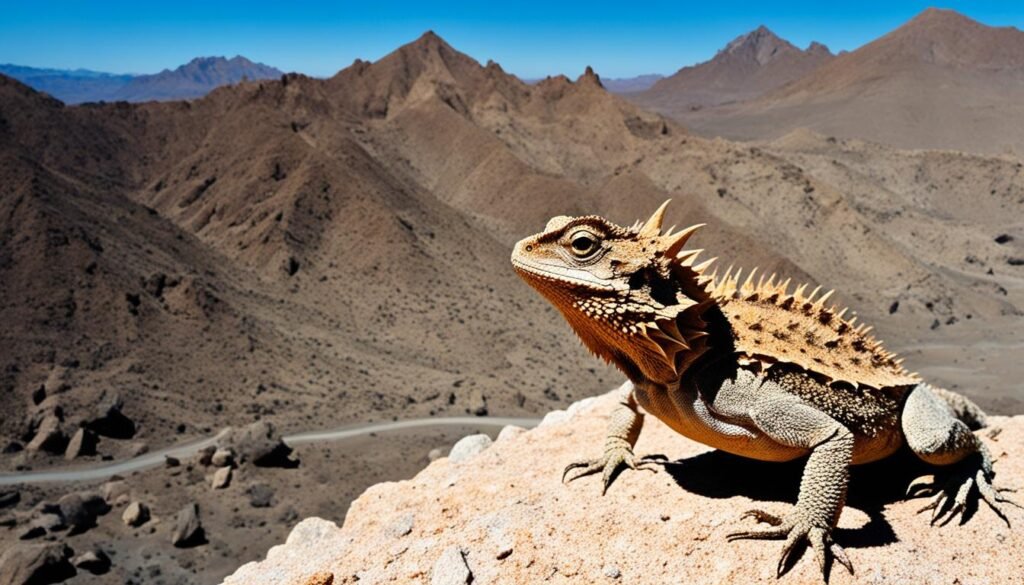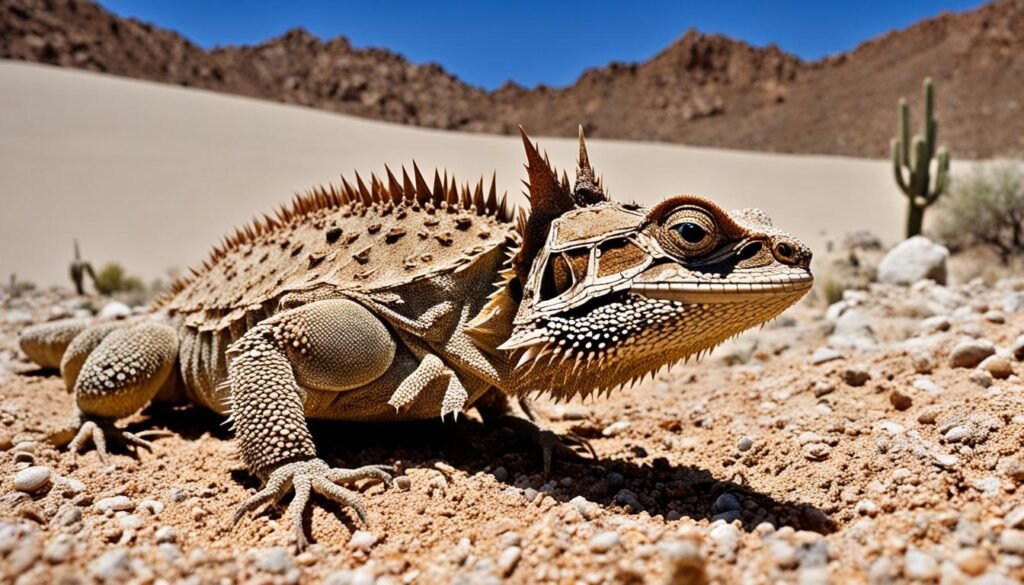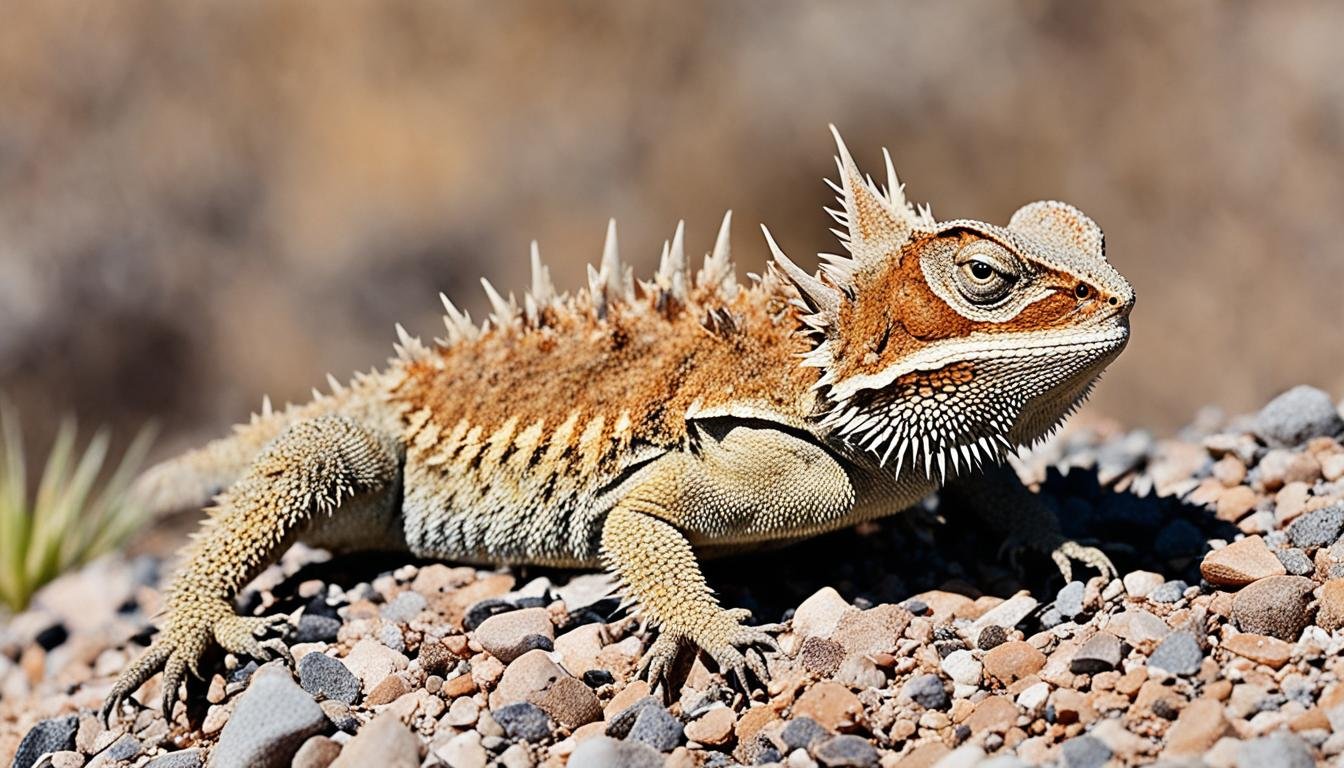Did you know that there are 16 different species of horned lizards found across the world? These unique reptiles, also known as “horny toads,” fascinate scientists and nature enthusiasts alike with their intriguing adaptations and survival skills. From their remarkable defense mechanisms to their specialized diet, horned lizards have developed incredible traits that allow them to thrive in their harsh habitats.
Key Takeaways:
- Horned lizards have 16 different species with various coloration, size, and horn arrangements.
- They thrive in hot, dry environments like deserts and woodlands.
- Horned lizards have defense mechanisms such as camouflage and blood-squirting from their eyes.
- Their diet mainly consists of ants, contributing to the control of ant populations in their ecosystems.
- Horned lizards face threats from habitat loss and human activities, making conservation efforts vital for their survival.
Horned Lizards: Masters of Camouflage
Horned lizards possess an extraordinary talent for camouflage, allowing them to seamlessly blend into their surroundings and evade the watchful eyes of predators. Their remarkable adaptation in coloration and patterns enables them to match rocks and desert sand, effectively concealing their presence.
When horned lizards sense danger, they have a remarkable defense mechanism. They possess the ability to puff up their bodies, making themselves appear larger and more intimidating. This behavior serves as a deterrent, warding off potential threats.
What sets certain species of horned lizards apart is their remarkable ability to change their skin color. They have the uncanny knack of adapting their appearance to match their immediate environment. This remarkable camouflage helps them stay hidden and increases their chances of survival when faced with predators.
Overall, the horned lizard’s mastery of camouflage and sophisticated defense mechanisms make them a true marvel of nature, allowing them to thrive in their challenging habitats and ensuring their survival in the face of adversity.
Stay tuned for the next section to explore the unique horns and spikes that adorn these fascinating creatures!
Unique Horns and Spikes of Horned Lizards
One of the distinguishing features of horned lizards is their impressive horns and spikes, which adorn their heads and bodies. These prominent features contribute to their tough and intimidating appearance, serving both as a form of protection against predators and a visual deterrent to potential threats.
The size, shape, and arrangement of horns vary among the different species of horned lizards, adding to the diversity within this fascinating reptile group. Some species exhibit long, crown-like horns that extend from the rear of their heads, while others possess shorter and more rounded spikes along their backs.
These distinctive horns and spikes not only make horned lizards visually striking but also serve a functional purpose. They provide some level of defense against predators, making it more challenging for them to attack or consume the lizards. Additionally, the presence of horns and spikes can make horned lizards appear less appealing as prey, further deterring potential predators from approaching.
These remarkable body features contribute to the overall adaptability and survival of horned lizards, allowing them to thrive in their diverse habitats. The ability to deter predators and protect themselves highlights the evolutionary success of these unique reptiles.
| Species | Horn Characteristics |
|---|---|
| Texas Horned Lizard | Long, crown-like horns protruding from the rear of the head. |
| Short-horned Lizard | Short, rounded spikes along the back. |
| Coast Horned Lizard | Short, curved horns resembling small hooks. |
Table: Horn Characteristics of Different Horned Lizard Species
Horned Lizard Diet: Ant Specialists
Horned lizards have a specialized diet consisting mainly of ants. They are truly ant specialists, utilizing their unique hunting techniques to capture and consume these tiny insects.
Their feeding process starts with their remarkable sense of sight. Horned lizards have keen eyesight, which helps them locate ant colonies in their environment. Once they identify a suitable target, they approach it cautiously, minimizing any disturbance that could alert the ants.
When the time is right, they strike with lightning speed, shooting out their long, sticky tongues to snatch up unsuspecting ants. Their tongues are coated with a sticky secretion that adheres to the ants, making it easier for the lizards to retrieve their prey.
But horned lizards don’t stop at a few ants. They are capable of consuming a staggering number of these insects in a single day. Some species can devour up to 2,000 ants, accounting for a significant portion of their daily intake. This is quite impressive considering that ants are small and relatively low in calories.
To accommodate their high ant consumption, horned lizards have adapted by developing large stomachs. These expandable stomachs allow them to store and digest the large quantities of ants they consume on a daily basis.
In addition to ants, horned lizards may also feast on other arthropods found in their native habitats. These can include spiders, beetles, grasshoppers, and pillbugs. However, ants remain the mainstay of their diet.
Their feeding habits have a profound impact on the ecosystems they inhabit. By preying on ants, horned lizards help regulate ant populations, preventing unchecked growth and maintaining a balance in their environment.
Overall, the Horned Lizard’s specialized diet of ants showcases its unique adaptations and demonstrates its role as an essential player in the delicate ecological web.
Adapting to Harsh Environments: Horned Lizard Survival Skills

Horned lizards are remarkable creatures that have developed a range of adaptations to survive in their challenging habitats. These adaptations enable them to thrive in arid environments such as deserts and grasslands.
Thick Skin
One of the key adaptations of horned lizards is their thick skin, which serves multiple purposes. The thick skin acts as a protective barrier against extreme temperatures and helps them retain moisture in dry habitats. This adaptation enables horned lizards to withstand the scorching heat of the desert and provides defense against predators.
Camouflage
Horned lizards are masters of camouflage. They have the ability to blend in seamlessly with their surroundings, making them almost invisible to predators. Their skin color and patterns match the rocks and sand of their habitat, allowing them to remain hidden and avoid detection.
Regulating Body Temperature
Horned lizards are adept at regulating their body temperature. They have the ability to bask in the sun to absorb heat when they need to warm up, and they can seek shade to cool down when temperatures rise. This skill enables them to maintain an optimal body temperature in their harsh environments.
| Adaptations | Benefits |
|---|---|
| Thick Skin | Protection against extreme temperatures and predators |
| Camouflage | Enhanced survival by blending in with the environment |
| Regulating Body Temperature | Maintaining optimal body temperature in different conditions |
These adaptations, combined with their specialized diet and other survival skills, equip horned lizards with the tools they need to thrive in their unique habitats. They are truly remarkable creatures that have found ways to adapt and thrive in the face of challenging conditions.
Threats to Horned Lizards and Conservation Efforts
Despite the unique adaptations and survival skills of horned lizards, they are currently facing significant threats due to habitat loss and development. As humans continue to encroach upon their habitats, these remarkable reptiles are being impacted by landscape disturbances, leading to a decline in their populations.
It is important to note that some states require permits for handling horned lizards as pets, as they do not fare well in captivity. These lizards have specialized needs and are best suited to their natural environments where they can thrive and fulfill their ecological roles.
To protect horned lizards and their habitats, extensive conservation efforts are underway. Organizations and researchers are working diligently to raise awareness about the importance of preserving these unique reptiles and their delicate ecosystems. They are actively engaged in habitat restoration projects and collaborate with local communities to implement measures that safeguard horned lizard populations.
Horned Lizard conservation initiatives focus on preserving their natural environments, minimizing habitat fragmentation, and mitigating the negative impacts of human activities. By conserving their habitats, we can ensure the long-term survival of not only horned lizards, but also the diverse species that depend on these ecosystems.
It is vital that we recognize the significance of horned lizards in maintaining the balance of their ecosystems and take necessary steps to protect them. By supporting conservation efforts and advocating for their protection, we can contribute to the preservation of these incredible reptiles for future generations to enjoy and appreciate.
Fascinating Facts about Horned Lizards

Horned lizards possess a multitude of captivating characteristics and behaviors that make them truly remarkable creatures to study. From unique eyelids to their communication methods, here are some fascinating facts about horned lizards:
Protective Eyelids
Horned lizards possess a distinctive feature – their one-of-a-kind eyelids that enable them to blink and safeguard their eyes from debris and potential harm.
Cold-Blooded Reptiles
As cold-blooded reptiles, horned lizards rely on their environment to regulate their body temperature. This adaptation allows them to function optimally in the arid and hot habitats they inhabit.
Communication through Body Language
Horned lizards communicate with each other through an intriguing form of body language. They employ various postures and movements, conveying messages to both rivals and potential mates.
Slow Movement and Camouflage
Horned lizards are recognized for their deliberate and slow movement. Unlike other reptiles that rely on agile escapes, horned lizards prefer to rely on their exceptional camouflage and specialized defense mechanisms to fend off predators.
These captivating facts about horned lizards highlight their unique characteristics and behaviors, which contribute to their survival in their respective habitats. Their evolutionary adaptations and intricate communication methods make them intriguing subjects for scientific inquiry and observation.
The Role of Horned Lizards in Ecosystems
Horned lizards, with their unique ecological role, contribute significantly to maintaining the balance of ecosystems. Their diet predominantly consists of ants, making them natural regulators of ant populations. By preying on ants, horned lizards help control their numbers, preventing overpopulation and maintaining the delicate equilibrium of the ecosystem.
This intricate ecological interaction has a cascading effect on the overall health and stability of the ecosystem. By regulating the population of ants, horned lizards indirectly benefit other animals that could potentially be stung by venomous ants, including humans. Their contribution plays a vital role in preserving the safety and well-being of the ecosystem’s inhabitants.
Preserving horned lizard populations is crucial for the long-term sustainability and health of their habitats. By safeguarding these reptiles, we ensure that the ecological functions they perform continue uninterrupted, ultimately leading to the overall preservation of biodiversity.
The Impact of Horned Lizards on Ecosystems
The presence of horned lizards within an ecosystem has both direct and indirect impacts on its ecological dynamics. Let’s explore some key aspects:
- Population Control: Horned lizards act as natural pest controllers, targeting ants that may have a detrimental impact on plants or other animals in the ecosystem. By preying on ants, horned lizards help maintain a balance between predator and prey, promoting a healthy ecosystem.
- Seed Dispersal: As horned lizards move across their habitat, they inadvertently assist with seed dispersal. Seeds can become attached to their scaly skin, providing a means of transportation to new areas of the ecosystem. This helps plants expand their range and increases overall biodiversity.
- Provision of Food: Horned lizards also serve as a food source for other predators within the ecosystem. Animals such as snakes and birds of prey rely on horned lizards as a vital part of their diet. This interdependence reinforces the intricate web of relationships within the ecosystem.
- Indication of Ecosystem Health: The presence or absence of horned lizards can serve as an indicator of an ecosystem’s health. Their sensitivity to environmental changes, particularly habitat degradation or pollution, highlights the need for conservation efforts to maintain a thriving ecosystem.
Understanding and valuing the pivotal role of horned lizards in ecosystems is essential for the preservation of biodiversity and the overall sustainability of our natural world.
| Key Ecological Role | Impact |
|---|---|
| Population Control | Regulates ant populations, promoting a balanced ecosystem |
| Seed Dispersal | Aids in expanding plant range and increasing biodiversity |
| Provision of Food | Serves as prey for other predators, sustaining the food web |
| Indication of Ecosystem Health | Sensitive to environmental changes, highlighting the need for conservation |
Conclusion
In conclusion, horned lizards are fascinating reptiles with unique adaptations and survival skills. These remarkable creatures have the ability to blend seamlessly into their surroundings, thanks to their incredible camouflage. Their specialized diet consisting of ants showcases their exceptional feeding habits. They have also developed impressive defensive mechanisms, such as puffing up their bodies and squirting blood from their eyes, to protect themselves from predators.
However, horned lizards face threats from habitat loss and human activities. As we continue to encroach upon their habitats, it is crucial to prioritize conservation efforts to preserve these incredible reptiles and their delicate ecosystems. By advocating for their protection and appreciating their role in maintaining biodiversity, we can contribute to the overall health and balance of our natural world.
In summary, horned lizards are not only captivating creatures with their unique appearance and fascinating behaviors, but they also play an important role in controlling ant populations, benefiting the overall balance of their ecosystems. It is essential that we recognize the value of these reptiles and take proactive steps towards their conservation. By working together, we can ensure the continued survival and flourishing of horned lizards for generations to come.
FAQ
How many species of horned lizards are there?
Where do horned lizards live?
What do horned lizards eat?
What are some of the defense mechanisms of horned lizards?
How do horned lizards obtain water in their dry habitats?
How do horned lizards protect themselves from predators?
What are some of the unique characteristics of horned lizards?
What role do horned lizards play in ecosystems?
What are the threats to horned lizards and what conservation efforts are in place?
References
| Organization Name | URL |
|---|---|
| Horned Lizard Conservation Society | http://www.hornedlizards.org |
| International Reptile Conservation Foundation (IRCF) | https://www.ircf.org/ |
| Herpetological Conservation International | https://herpconservation.com/index.html |


10 thoughts on “Horned Lizard Facts: Habitat & Survival Skills”